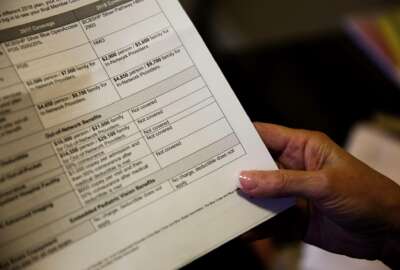
60% of feds in wrong health plan — does that include you?
With 10 working days to go until the health insurance open season ends, the $2,000-to-$3,000 question to ask is are you in the right Federal Employees Health...
With 10 working days to go until the health insurance open season ends, the $2,000-to-$3,000 question to ask is are you in the right Federal Employees Health Benefits Program plan? Can you really afford to sleepwalk during the chance to pick the health plan that will cover you and yours next year, if 2020 is the year that produces catastrophic medical costs because of a major accident or medical situation?
It could be a year when out-of-pocket costs for a family of three ranges from $8,300 to more than $20,000, depending on which plan you are in when the worst happens. That out-of-pocket cost is out of your pocket!
And according to the man who wrote the book on the FEHBP health plans only about 6% of all feds, and even fewer retirees, switch plans each year when in fact 60% or more of you may be in the “wrong” plan. It’s not a bad plan, but it’s wrong for you in the sense of its premium are too high for what you might get in return.
First consider this point: All the FEHBP plans are good to excellent and the government will pay roughly two-thirds of the total premium. The problem is that with 30 fast-evolving health plan choices available to most feds — 40 in the metropolitan Washington, D.C., area — there are a lot of choices. And while you may be in an excellent plan, its premiums may be too high. There’s a good chance many if not most feds and retirees could get the same coverage with the same doctors in their network and save a couple of thousands dollars in premiums next year. That’s according to Walton Francis, long-time editor of Consumers’ Checkbook “Guide to Health Plans For Federal Employees.”
But with 30 to 40 choices of plans and options, where do you start? How do you know if you are probably paying too much in premiums, if you could save a lot of money simply by shifting from the Standard Option of your plan into its equally good Basic Option?
Take this simple test:
- Are you still in the same plan you had when the impeachment proceedings began — Clinton, not Trump?
- Did you last decide to shop, do you health plan homework and actually switch health plans during your favorite show “Mad Men,” or “Fresh Off The Boat,” or maybe even “The Leftovers” was your companion in 2015?
- How many health plans, other than Blue Cross Blue Shield, Aetna, Kaiser or GEHA can you name? Remember there are 7 brand new plans this year. Do have a clue what they are called, how their premiums stack up, and how their premiums and their “catastrophic” coverage stack up?
For bare bones shopping Francis recommends choosing three plans, including your own, and compare premiums, catastrophic coverage (out-of-pocket to you), prescription drug benefits and whether your doctor will be in-network in 2020. You can go online on the Office of Personnel Management website, or check out Checkbook’s paper book guide ($10.95) at many D.C.-area drug stores.
Many people prefer Checkbook’s online version. You can buy it yourself but first check to see if your agency or union or professional association has done it for you. Workers at the departments of Labor, Education, and Health and Human Services can get it free at the office, as well as employees of the Congressional Budget Office, Environmental Protection Agency, Federal Energy Regulatory Commission, the Federal Reserve, OPM, Library of Congress, the U.S. Postal Service, members of the National Treasury Employees Union and the American Foreign Service Association — among many others.
To see if you get the perk free, at the office, click here.
Walt Francis will be our guest on this Wednesday’s episode of our Your Turn radio show. He’ll run through the highlights of different plans, tell how you can pick a plan that will pay most of the premiums and give you an IRA on steroids, and explain why catastrophic coverage — which most people don’t like to think about — is actually the first thing you should think about.
Nearly Useless Factoid
By Amelia Brust
Gilroy Gardens Theme Park in California is home to the “circus trees” of Axel Erlandson, a Swedish-American farmer who developed a talent for growing mind-bending trees. Erlandson taught himself to cultivate and skillfully prune sycamores with complex inosculations, lattice-style tree trunks and other shapes.
Source: Wikipedia
Copyright © 2025 Federal News Network. All rights reserved. This website is not intended for users located within the European Economic Area.
Mike Causey is senior correspondent for Federal News Network and writes his daily Federal Report column on federal employees’ pay, benefits and retirement.
Follow @mcauseyWFED




